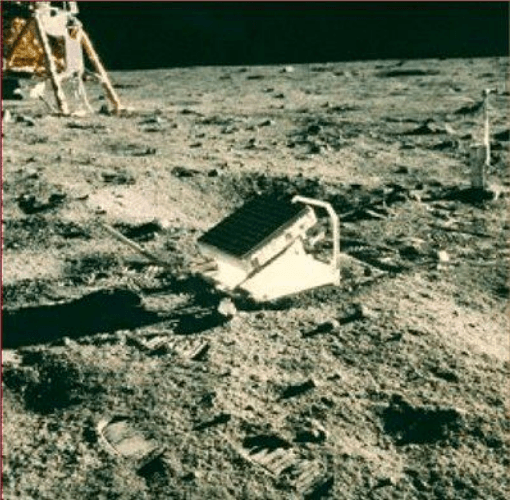
Look how a single candle can both defy and define the darkness — Anne Frank
In 1919, a total eclipse expedition led by Arthur Eddington helped verify Albert Einstein’s theory of general relativity. By observing the eclipse from the African island of Principe, Eddington was able to show that light paths are bent by gravity. In 2019, the European Space Agency’s Atomic Clock Ensemble in Space (ACES) is being prepared to fly to the International Space Station aboard a SpaceX Falcon 9. In space, an atomic clock is more accurate than a clock on Earth, because the gravitational pull on Earth’s surface will not affect the vibration of atoms. As described in the ESA website, the basic ACES question is: Does the speed of light change with time?

Image by NASA is licensed under CC0
In 1969, Apollo 11 landed on the Moon. The Lunar Laser Ranging Experiment left behind by Apollo astronauts allows precise measurements of the Moon’s distance from Earth. The distance is known to be increasing due to tidal interaction between Earth and Moon. Lunar data also may show that the speed of laser light is changing.
LLRE reports the lunar distance increasing by just 3.82 +/- .07 cm/yr, but that is too fast. If the Moon were today gaining momentum at this rate, it would have been in the same place as Earth just 1.5 billion years ago. Studies of lunar samples, which this author has participated in, show conclusively that the Moon has existed separate from Earth for 4.5 billion years.
Independent experiments disagree with LLRE. One experiment uses tidal rhythmites, fossils left by ancient lunar tides. Another uses 2700 years of historical eclipse observations to measure how the Moon’s orbit is changing. A third dataset is from numerical simulation of the Earth-Moon interaction. All three agree that the Moon is receding at only 2.9 cm/yr. Scientists usually consider 5-Sigma as significant, this is a 12-Sigma result. The peer-reviewed paper Calculation of Lunar Orbit Anomaly has been downloaded over 10,000 times.
The lunar anomaly, and many other things, may be explained by a simple equation:
GM=tc3
where G is Newton’s gravitational constant, and M and t are mass and age of the universe.
By this hypothesis, when t was small, the speed of light c was immensely fast, causing the universe to expand in a big bang. As t increased, expansion slowed due to G gravity and M mass. This predicts that c is still slowing at a very small rate, just 0.72 cm/sec per year. This tiny change may be revealed in the lunar anomaly.
If the speed of laser light were changing today, time for light to return from the Moon would increase each year, making its distance appear to increase faster as seen by LLRE. The predicted change is .926 cm/yr, matching the 12-Sigma anomaly within 1/5 of a standard deviation. This is one of the most accurate scientific predictions of all time. It is the subject of a popular book, THE SPEED OF LIGHT, now on its 2nd edition.
The speed of light affects everything from your computer to the Earth’s climate. As an example, it shines a light on the “Faint Young Sun Paradox.” According to old models of the Sun, life could not have evolved on Earth because 4 billion years ago, the Sun was only 75% as bright, and Earth would have been frozen solid. However, we have plenty of evidence that Earth had liquid oceans and the beginnings of life, even indicators that Mars was warm enough for life several billion years ago.
The Sun turns its fuel into energy according to E=mc2. If c were greater in the amount predicted, Earth’s temperature 4 billion years ago would be almost exactly today’s value. Models of the Sun also predict that it will get hotter until Earth’s oceans vaporize. Thanks to the speed of light, Earth will maintain a comfortable temperature for a very long time. If c were not changing, human life would not be here to talk about it.
For decades, theorists imagined that the universe “inflated” many times faster than light, though this would violate many physical laws. No direct evidence can be found of this cosmic “inflation.” A much-publicized announcement in 2014 of waves from “inflation” turned into cosmic dust. If the speed of light were faster in the early universe, it would explain the early universe without “inflated” ideas.
Finally, a changing c would solve the biggest problem in physics, the appearance of cosmic acceleration. Since the time of Edwin Hubble we have measured the universe expanding because as an object’s distance increases, its light appears shifted into the red. When physicists measured distant exploding stars, supernovae, their redshifts appeared to increase non-linearly, as if their region of the universe was accelerating away from us. This has caused rampant speculation that mysterious “dark energy” is causing the universe to accelerate.
Darkness cannot drive out darkness, only light can do that — Martin Luther King
Redshifts are related to the speed of light. If c has been changing in precisely the amounts predicted, the apparent acceleration would be explained without any repulsive “dark energy.” A simple equation predicts the “accelerating” data precisely. A changing c would solve the many problems of both “inflation” and “dark energy,” as described in this paper.
Science is in a crisis. Measurements of the Hubble-Lemaître constant, those which appear to show that expansion is accelerating, do not agree. Many scientists believe that old models of the universe are flawed, and new physics is needed. A changing c is studied by a growing number of researchers as an alternative to older models. The Atomic Clock Ensemble in Space may potentially verify a “c change” in physics, a huge advance in our understanding of the universe. Time will tell!
These findings are described in the article entitled Calculation of lunar orbit anomaly, recently published in the journal Planetary Science.









